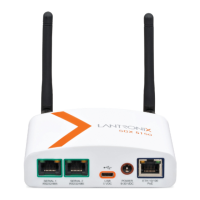9: Administration
SGX 5150 IoT Device Gateway User Guide 127
To Configure USB Settings
Using Web Manager
To configure usb settings, on the Administration page, click USB > Configuration.
Using the CLI
To enter the usb command level: enable > usb
Using XML
Include in your file: <configgroup name="usb">
USB Command Mode
Table 9-55 USB Command Mode
To Configure USB Command Mode
Using Web Manager
To configure usb command mode, on the Administration page, click USB > Command
Mode.
Line Mode Select the USB port mode from the drop-down menu. The USB port can be
configured in one of the following: Ethernet Device, Serial Device, or Host. Host
mode supports connecting Mass Storage and Serial devices.
Gap Timer Indicate the gap time in milliseconds. The driver forwards received serial bytes after
the Gap Timer delay from the last character received. By default, the delay is four
character periods at the current baud rate (minimum 1 ms).
Threshold Enter the threshold in bytes. The driver will forward received characters after
threshold bytes have been received.
USB Command Mode
Settings
Description
Mode When Command Mode is enabled, the Command Line Interface (CLI) is attached to
the USB Line. Command Mode can be enabled in a number of ways:
The Always choice immediately enables Command Mode for the USB Line.
The Use Serial String choice enables Command Mode when the Serial String is
read on the USB Line during boot time.
Disabled
Wait Time Enter the Wait Time in milliseconds. The specified time defines the amount of time
to wait during boot time for the Serial String. This timer starts right after the Signon
Message has been sent on the USB Line.
Serial String Enter the Serial String. The Serial String is a string of bytes that must be read on
the USB Line during boot time in order to enable Command Mode. It may contain a
time element to specify a required delay in milliseconds x, formed as {x}.
Echo Serial String Select to enable or disable.
Signon Message Enter the Signon Message, which is a string of bytes that is sent on the USB Line
during boot time. Place a binary character into either the Serial String or the Signon
Message using [x]. For example, use decimal [12] or hex [0xc].
USB Settings Description

